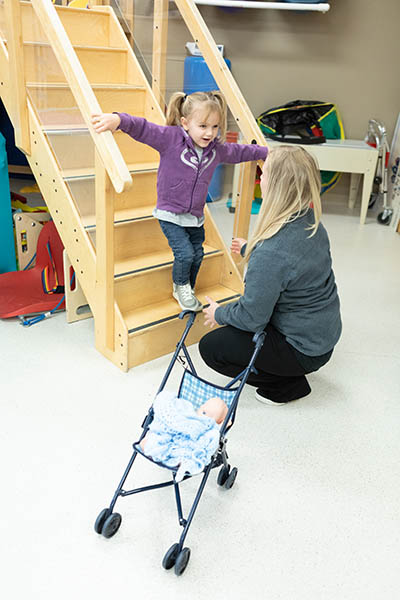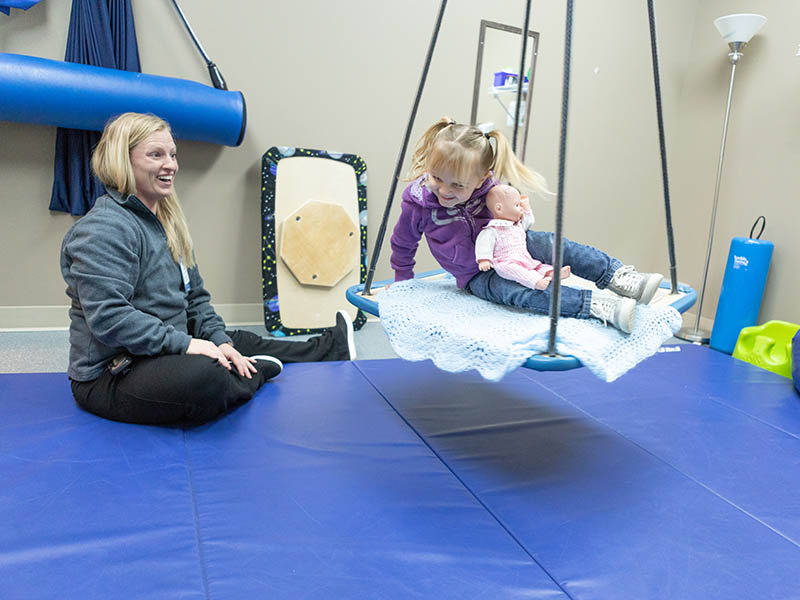Mataya Duvall has changed a lot since she started physical therapy a few years ago.
The soon-to-be 4-year-old, known for her independent streak, recently mastered forearm crutches. She hadn’t started crawling yet when she began therapy. And instead of crying if her mom leaves the session, Mataya now cries when told she has to go home.
Learn more: Sanford Children’s rehabilitation and therapy
Mataya also attends a preschool program, and “she will talk to you about anything,” said her mom, Nicole. She tries to copy what her older siblings do.
Determination seems in her nature. No doubt it helped in her first days and months as she faced severe health issues that threatened her life.
Rare disease requires chemo
No one knew it right away, but Mataya came into the world with a chest full of cancer.
However, they did know that Mataya wasn’t breathing when she was born via caesarian section. She had meconium aspiration; she had breathed in a mixture of early feces and amniotic fluid. It was suctioned out, but her left lung had completely collapsed.
Born in January at Sanford Bemidji Medical Center, Minnesota, Mataya was airlifted six hours later, in 24-below weather, to the neonatal intensive care unit (NICU) at Sanford Children’s Hospital Fargo, North Dakota.
Concerned about pneumonia, the medical staff started IV antibiotics, nebulizers and chest physical therapy to try to get Mataya’s left lung to open, Nicole said. But when X-rays showed no improvement after three days, a CT scan revealed Mataya’s true predicament.
A large mass had wrapped around Mataya’s spine and aorta and filled the left side of her chest.
Mataya had been born with neuroblastoma, a disease in which cancer cells form in very early nerve tissue. Children are usually diagnosed by age 5, according to the American Cancer Society, with about 800 new cases occurring in the U.S. each year.
At just 9 days old, Mataya had her first chemo treatment. The tumor was squeezing her spine, possibly threatening her ability to walk in the future.
Complication: ruptured intestines
Mataya spent 68 days in the NICU, with Nicole and her husband, Steve, trading weeks of staying with her in Fargo versus staying with their three other children in Bemidji.
“It was hard,” Nicole said. On weekends, they often met in Detroit Lakes, Minnesota, to switch so their three children wouldn’t have to ride the entire distance, two and a half hours one way. But sometimes they all stayed in Fargo at the Ronald McDonald House, or occasionally in a donated hotel room.
Related: Girl finds support in specialists for rare disorder and cancer
Mataya was set to have seven rounds of chemo every three weeks in Fargo. After every round, though, she would get sick. When she left the hospital to go home, she would have to be taken back after a few days because she had become so severely ill.
After her sixth round, she got even worse during her hospital stay. Her intestines had twisted, and her stomach swelled. “She looked like a little sumo wrestler,” Nicole said.
But then her intestines ruptured, and she had emergency surgery to remove the section of her bowel that had died.
Mataya, sedated and with sepsis now besides, needed additional blood and platelets — up to three transfusions a day. She ended up with a double ileostomy for about a month until her intestines could be reattached.
Chemo treatments were halted after that, but “she’s been cancer-free since she was 6 months old,” Nicole said. She gets regular follow-up scans, but at this point, her parents were told that she has less than a 10 percent chance of the neuroblastoma recurring.
Other medical concerns
Mataya has had other medical issues in her young life, too. She had an NG feeding tube — through her nose — in the NICU, but she kept vomiting. At 2 months old, a GJ feeding tube was placed, extending into her small intestine to prevent vomiting. A switch in formulas eventually helped resolve the vomiting issue; she hadn’t been able to digest the first one. She also took Prilosec until recently.
Even after her chemo treatments were over, Mataya kept getting sick every few months and would end up in the hospital for several days each time. It was discovered that she had been getting urinary tract infections from reflux that extended up to her right kidney — a backward flow.
As it turned out, her bladder pressure was extremely high because the tumor had “damaged the nerves that talk to her bladder,” Nicole said.
So Mataya takes an overactive bladder medication and has catheterization four times a day. She’s been free of urinary tract infections for nearly two years.
However, Nicole said, half of her right kidney is just scar tissue from the infections. So between the scarring and the effects of chemo, she has been diagnosed with stage 3 chronic kidney disease. But so far, it’s stable.
Mataya loves to swing
Free from worries of hospital stays these days, much of Mataya’s life sounds like the typical preschooler’s. “She’s all about ‘criss-cross applesauce’ in school,” Nicole said.
She loves swinging — so much that her school called Nicole one day when Mataya had accomplished quite a feat. She maneuvered her wheelchair, which she keeps at school for moving long distances, over wood chips to the swings. While one person held the swing still, Mataya moved herself from the wheelchair to the swing “all by herself,” Nicole said.
Swinging is one of her favorite things about physical therapy, too — she asks to do it every time. Swinging helps Mataya work on using her stomach and back muscles to stay upright, says physical therapy assistant Jamie Thompson, who works with patients at Sanford Bemidji Children’s Therapy.
Thompson and a colleague focus on helping Mataya’s legs as well. Mataya has a lot of spasticity in her muscles, so she gets Botox injections in her legs every few months and takes a daily oral medication to relax those muscles. Spending time in the 93-degree therapeutic pool at Children’s Therapy helps, too.
Therapy techniques
Outside of the pool, Thompson uses a variety of tools to hold Mataya’s interest.
Right now, one goal for her therapy is to get her to march rather than dragging her toes. The spider cage in the gym area is a large metal-framed box that Thompson can use for strengthening, using weights and a pulley system to help build up Mataya’s hip flexor strength to pick up her legs. Mataya lies on her back in the spider cage and mimics a march while actually moving a weight with her leg.
Enlarge

Photo by Jose D. Medina Medrano, Sanford Health
Also in the spider cage, Mataya can stand up fully supported by a harness that’s attached to the sides with bungee-type cords. In that position, she can work on marching along with standing straight. Another of her goals is to be able to stand independently without losing her balance for 15 seconds. She’s also working on ascending and descending stairs safely.
Because Mataya loves music, Thompson uses it to help motivate her and keep her interested in all of the exercises. “One time, I was going back and forth between ‘Wheels on the Bus’ and ‘Baby Shark’ — 45 minutes,” Thompson said.
Thompson is glad to be part of a group that can provide a service her patients don’t have to travel far to get. “We just care about our kids and want to give them the best services that they can have and provide them the best life that they deserve,” she said.
Clearly, Mataya enjoys her sessions. “Some nights,” Thompson said, “she’s my last patient of the day, and I have to tell her, ‘We’re closing.’ And I have to turn down all the lights just to get her to go.”
Providing solutions through sewing
Sanford Bemidji Children’s Therapy also helps Mataya and other children in a unique way. Thanks to the sewing skills of one of the occupational therapists on staff, kids can get custom-made devices when another therapist or a parent identifies a need.
For example, Mataya needed some knee immobilizers, but some manufactured ones caused pressure sores on her knees. Custom-made ones with a little bit of a bend, but still able to straighten, were the answer.
And when Mataya started crawling, she dragged her knees. To save her skin, knee pads were made with a gripping material on the inside that kept them from sliding off.
“I actually still use them because if you bring her to a pool, she’ll crawl, and she doesn’t notice that her skin is being rubbed right off,” Nicole said. “So she has to wear water shoes and those knee pads.”
Compound medications
Another convenience Nicole has appreciated is the Sanford Health pharmacy located right next to the pediatric clinic in Bemidji. This pharmacy has the ability to compound medications: to prepare a particular medication, a combination of medications or a form of medication, none of which are currently available from a manufacturer.
Say you’re a parent whose young child needs a medication for a typically adult condition that comes in tablet form only. Your child can’t, or won’t, swallow that tablet. But the pharmacist can turn it into a liquid form that your child can swallow far more easily. It also can help fine-tune the dose to a patient’s specific weight.
It can be rare to find a pharmacy that compounds medications because of the rules and guidelines that must be followed and the additional space it requires. It’s just not cost-effective for most pharmacies, said John Carlin, a pharmacist at that Sanford Health location who prepares compound medications. He thinks the closest pharmacies that can prepare compound medications are Fargo and Sartell, Minnesota, both about two and a half hours away.
Carlin said compounding is probably what people think of pharmacists doing traditionally. Now, “it is kind of a lost art that’s not really done very much anymore,” he said.
But there’s still a need. “You really feel like you’re providing that special service to a special kid like Mataya,” Carlin said.
Mataya’s oral medication to relax her muscles gets compounded there. And while she was getting chemo treatments, a special diaper cream was made there, too. But one time the Bemidji pharmacy didn’t have the ingredients for it, so Nicole had to head to Fargo.
“We made a special trip — a five-hour drive — for diaper cream,” she said.
More stories
…
Posted In Bemidji, Cancer, Cancer Treatments, Children's, Detroit Lakes, Neurology, Rehabilitation & Therapy, Specialty Care
